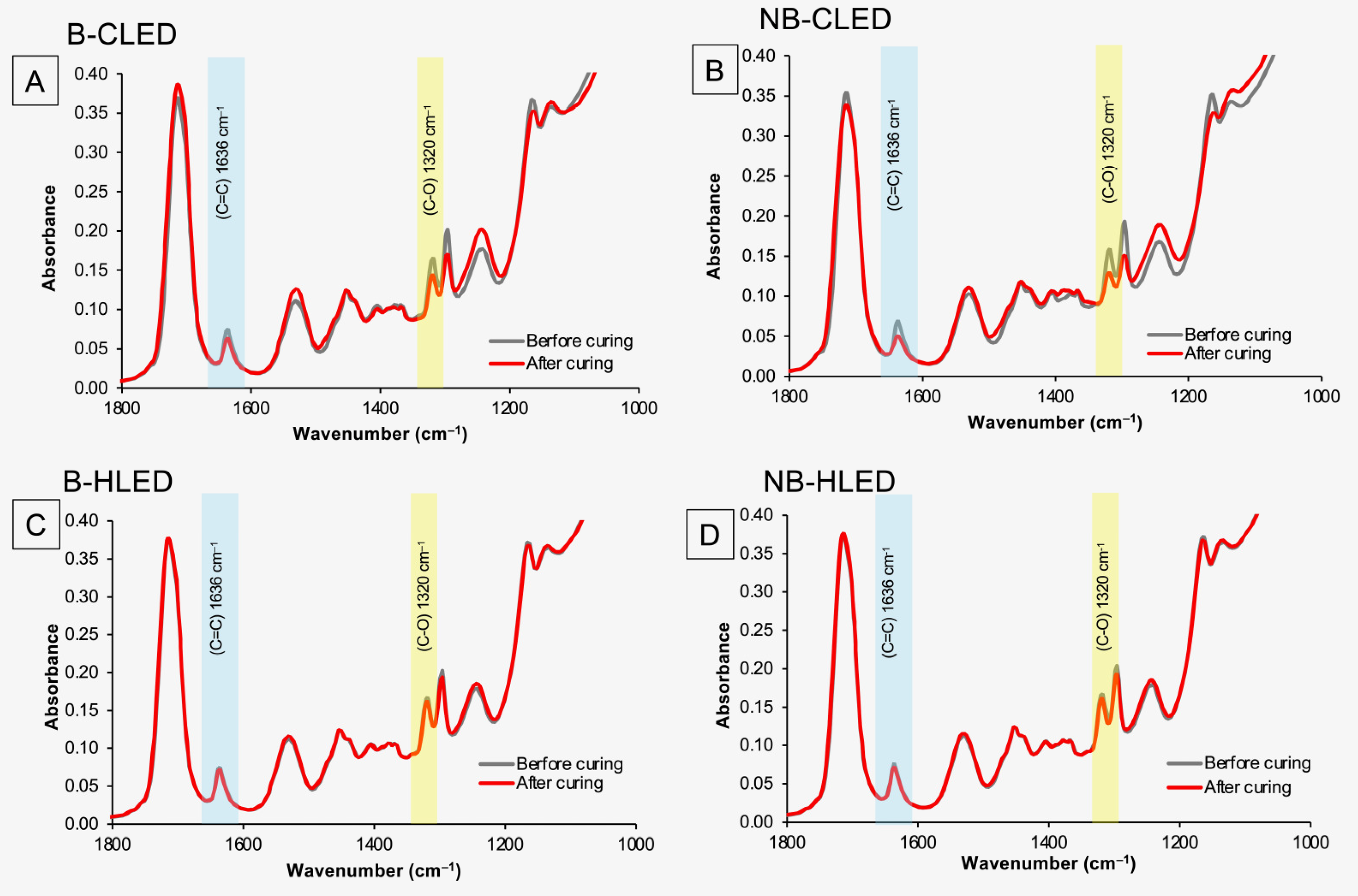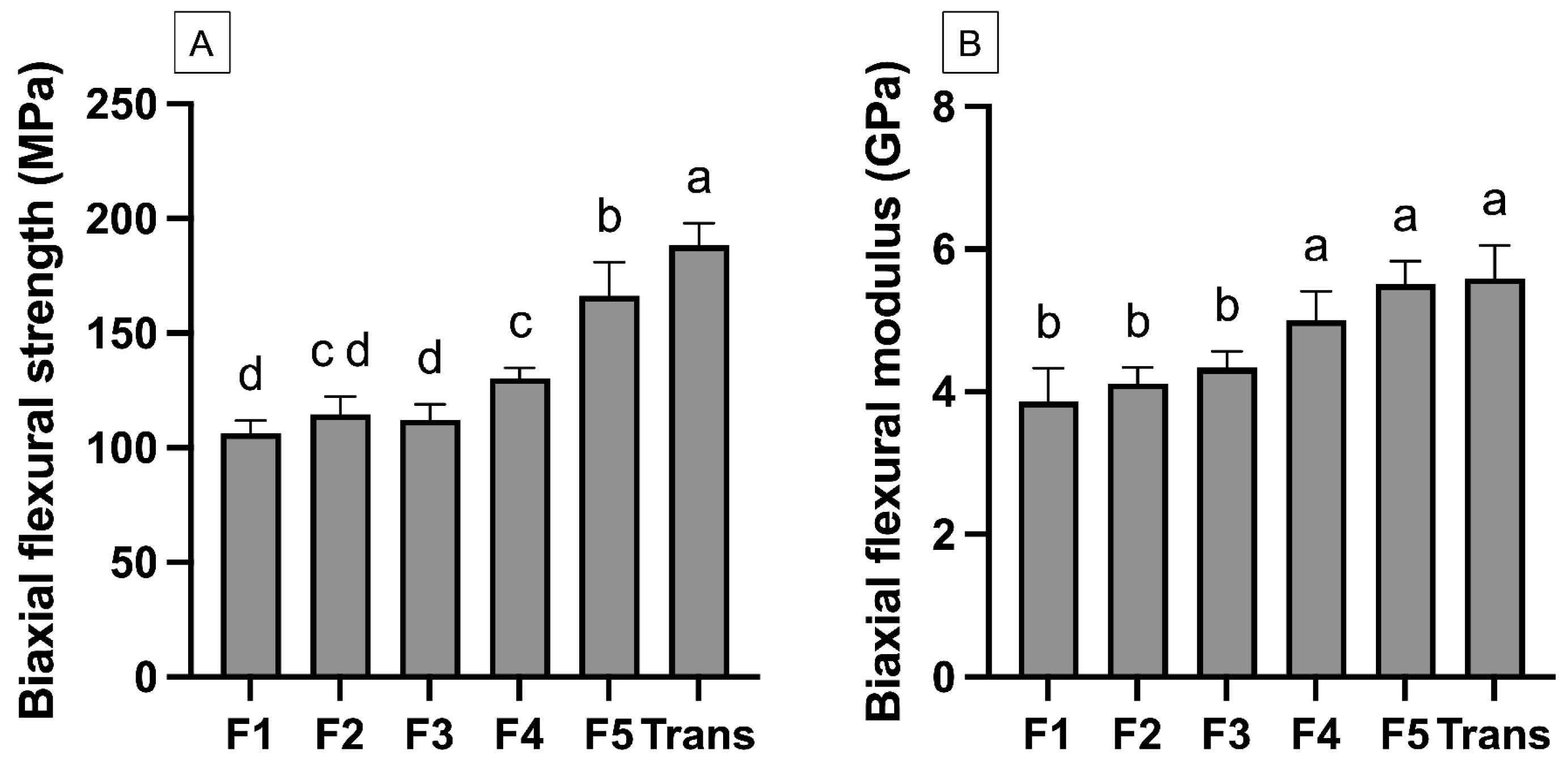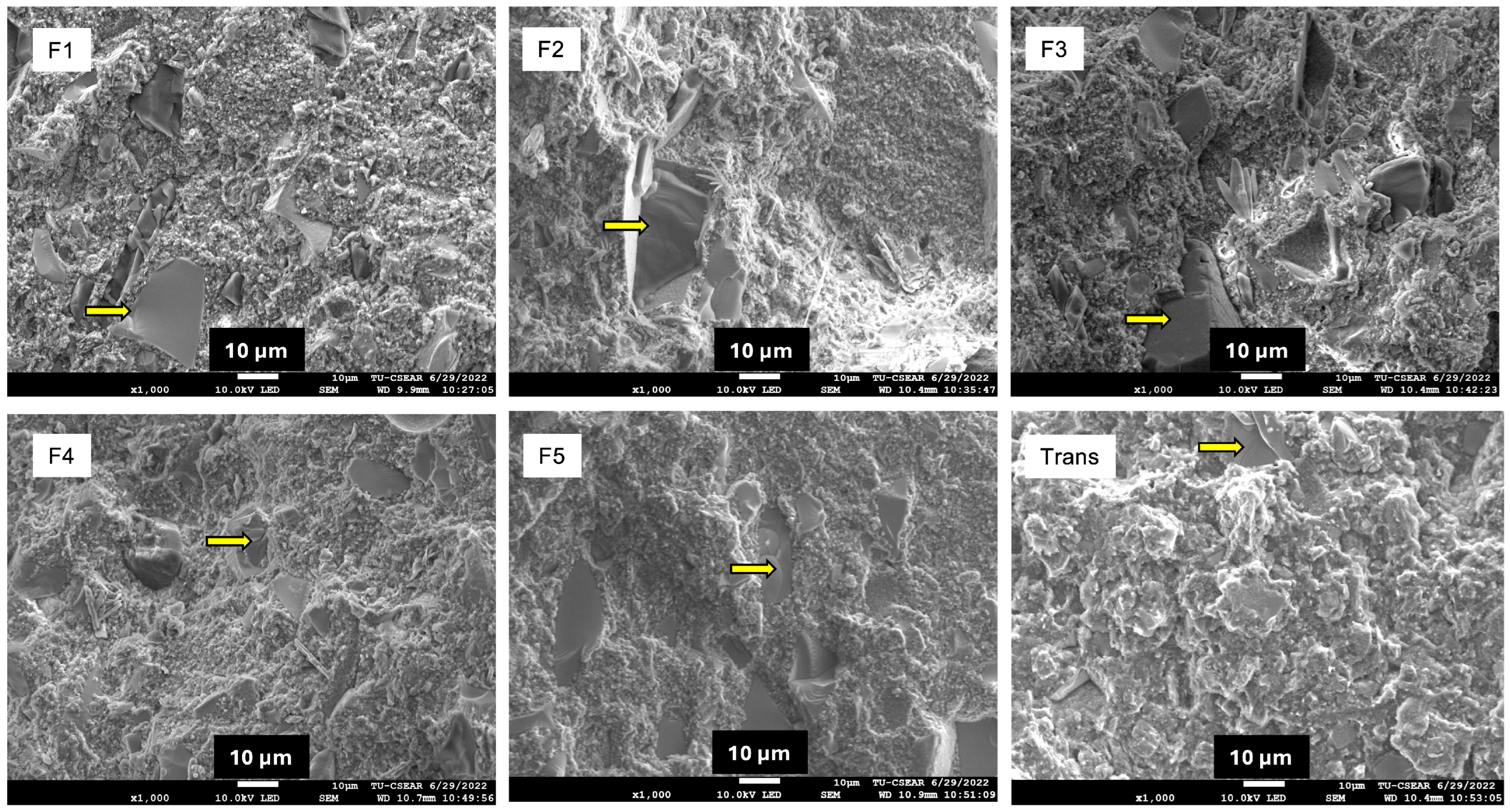The Evaluation of Degree of Monomer Conversion, Biaxial Flexural Strength, and Surface Mineral Precipitation of Orthodontic Adhesive Containing Sr-Bioactive Glass Nanoparticles, Calcium Phosphate, and Andrographolide
Abstract
1. Introduction
2. Materials and Methods
2.1. Material Preparation
2.2. Degree of Monomer Conversion
| Group | Bracket Presence | Light-Curing Protocol | Time (On Each Mesial and Distal Side) | Manufacturer of Light-Curing Unit |
|---|---|---|---|---|
| NB-CLED | No | Conventional LED SmartLite (1200 mW/cm2) | 20 s | DENTSPLY Sirona, York, PA, USA |
| NB-HLED | No | High-intensity LED Valo Grand (3200 mW/cm2) | 3 s | Ultradent Products Inc., South Jordan, UT, USA |
| B-CLED | Yes | Conventional LED SmartLite (1200 mW/cm2) | 20 s | DENTSPLY Sirona, York, PA, USA |
| B-HLED | Yes | High-intensity LED Valo Grand (3200 mW/cm2) | 3 s | Ultradent Products Inc., South Jordan, UT, USA |
2.3. Biaxial Flexural Strength and the Modulus of Elasticity
2.4. Surface Mineral Precipitation
2.5. Statistical Analysis
3. Results
3.1. Degree of Monomer Conversion
3.2. Biaxial Flexural Strength (BFS) and the Biaxial Flexural Modulus (BFM)
3.3. Surface Mineral Precipitation
4. Discussion
5. Conclusions
Author Contributions
Funding
Institutional Review Board Statement
Informed Consent Statement
Data Availability Statement
Acknowledgments
Conflicts of Interest
Abbreviations
| ATR-FTIR | Attenuated total reflection Fourier transform infrared spectroscopy |
| B | Bracket coverage |
| BAG | Bioactive glass |
| BFM | Biaxial flexural modulus |
| BFS | Biaxial flexural strength |
| CLED | Conventional LED curing |
| CQ | camphorquinone |
| DC | Degree of monomer conversion |
| EDX | Energy dispersive X-ray |
| HEMA | 2-hydroxyethyl methacrylate |
| HLED | High-intensity LED curing |
| ISO | International organization for standardization |
| LED | Light-emitting diode |
| MCPM | Monocalcium phosphate monohydrate |
| NB | No bracket coverage |
| SEM | Scanning electron microscope |
| TEGDMA | triethyleneglycol dimethacrylate |
| Trans | Transbond XT |
| UDMA | urethane dimethacrylate |
References
- Sonesson, M.; Brechter, A.; Lindman, R.; Abdulraheem, S.; Twetman, S. Fluoride varnish for white spot lesion prevention during orthodontic treatment: Results of a randomized controlled trial 1 year after debonding. Eur. J. Orthod. 2021, 43, 473–477. [Google Scholar] [CrossRef]
- Livas, C.; Kuijpers-Jagtman, A.M.; Bronkhorst, E.; Derks, A.; Katsaros, C. Quantification of white spot lesions around orthodontic brackets with image analysis. Angle Orthod. 2008, 78, 585–590. [Google Scholar] [CrossRef] [PubMed]
- Sundararaj, D.; Venkatachalapathy, S.; Tandon, A.; Pereira, A. Critical evaluation of incidence and prevalence of white spot lesions during fixed orthodontic appliance treatment: A meta-analysis. J. Int. Soc. Prev. Community Dent. 2015, 5, 433–439. [Google Scholar] [CrossRef] [PubMed]
- Dunleavy, G.; Verma, N.; Raghupathy, R.; Jain, S.; Hofmeister, J.; Cook, R.; Vujicic, M.; Kebschull, M.; Chapple, I.; West, N.; et al. Inequalities in oral health: Estimating the longitudinal economic burden of dental caries by deprivation status in six countries. BMC Public. Health 2024, 24, 3239. [Google Scholar] [CrossRef] [PubMed]
- Benson, P.E.; Parkin, N.; Millett, D.T.; Dyer, F.E.; Vine, S.; Shah, A. Fluorides for the prevention of white spots on teeth during fixed brace treatment. Cochrane Database Syst. Rev. 2004, 3, CD003809. [Google Scholar] [CrossRef]
- Profeta Krznar, I.; Par, M.; Tarle, Z.; Meštrović, S. Influence of the Bracket Material on the Post-Cure Degree of Conversion of Resin-Based Orthodontic Adhesive Systems. Polymers 2024, 16, 318. [Google Scholar] [CrossRef]
- Dalessandri, D.; Dalessandri, M.; Bonetti, S.; Visconti, L.; Paganelli, C. Effectiveness of an indirect bonding technique in reducing plaque accumulation around braces. Angle Orthod. 2012, 82, 313–318. [Google Scholar] [CrossRef]
- Almosa, N.A.; Alqasir, A.M.; Aldekhayyil, M.A.; Aljelayel, A.; Aldosari, M.A. Enamel demineralization around two different orthodontic bracket adhesive systems: An in vivo study. Saudi Dent. J. 2019, 31, 99–104. [Google Scholar] [CrossRef]
- Fernandes, M.; Lourenco, T.; Lopes, A.; Spinola Santos, A.; Pereira Santos, M.C.; Pereira Barbosa, M. Chlorhexidine: A hidden life-threatening allergen. Asia Pac. Allergy 2019, 9, e29. [Google Scholar] [CrossRef]
- Abou Neel, E.A.; Aljabo, A.; Strange, A.; Ibrahim, S.; Coathup, M.; Young, A.M.; Bozec, L.; Mudera, V. Demineralization-remineralization dynamics in teeth and bone. Int. J. Nanomed. 2016, 11, 4743–4763. [Google Scholar] [CrossRef]
- Panpisut, P.; Liaqat, S.; Zacharaki, E.; Xia, W.; Petridis, H.; Young, A.M. Dental Composites with Calcium / Strontium Phosphates and Polylysine. PLoS ONE 2016, 11, e0164653. [Google Scholar] [CrossRef]
- Aljabo, A.; Xia, W.; Liaqat, S.; Khan, M.A.; Knowles, J.C.; Ashley, P.; Young, A.M. Conversion, shrinkage, water sorption, flexural strength and modulus of re-mineralizing dental composites. Dent. Mater. 2015, 31, 1279–1289. [Google Scholar] [CrossRef] [PubMed]
- Chanachai, S.; Chaichana, W.; Insee, K.; Benjakul, S.; Aupaphong, V.; Panpisut, P. Physical/Mechanical and Antibacterial Properties of Orthodontic Adhesives Containing Calcium Phosphate and Nisin. J. Funct. Biomater. 2021, 12, 73. [Google Scholar] [CrossRef]
- Tkacikova, S.; Sabo, J. Release of Monomers from Dental Composite Materials into Saliva and the Possibility of Reducing the Toxic Risk for the Patient. Medicina 2023, 59, 1204. [Google Scholar] [CrossRef]
- Dureja, A.; Acharya, S.R.; Kini, S.; Mayya, A.; Hedge, V. Biocompatibility and Performance of Dental Composite Restorations: A Narrative Review on Free Monomer Release, Concerns and Solutions. Eng. Proc. 2023, 59, 160. [Google Scholar]
- Almeida, R.; Manarte-Monteiro, P.; Domingues, J.; Falcao, C.; Herrero-Climent, M.; Rios-Carrasco, B.; Lemos, B.F. High-Power LED Units Currently Available for Dental Resin-Based Materials-A Review. Polymers 2021, 13, 2165. [Google Scholar] [CrossRef]
- Papadogiannis, D.; Iliadi, A.; Bradley, T.G.; Silikas, N.; Eliades, G.; Eliades, T. Viscoelastic properties of orthodontic adhesives used for lingual fixed retainer bonding. Dent. Mater. 2017, 33, e22–e27. [Google Scholar] [CrossRef]
- Torres, C.R.G.; Prado, T.P.; Avila, D.; Pucci, C.R.; Borges, A.B. Influence of Light-Curing Time and Increment Thickness on the Properties of Bulk Fill Composite Resins With Distinct Application Systems. Int. J. Dent. 2024, 2024, 2123406. [Google Scholar] [CrossRef] [PubMed]
- Chaichana, W.; Insee, K.; Chanachai, S.; Benjakul, S.; Aupaphong, V.; Naruphontjirakul, P.; Panpisut, P. Physical/mechanical and antibacterial properties of orthodontic adhesives containing Sr-bioactive glass nanoparticles, calcium phosphate, and andrographolide. Sci. Rep. 2022, 12, 6635. [Google Scholar] [CrossRef]
- Delgado, A.H.S.; Young, A.M. Methacrylate peak determination and selection recommendations using ATR-FTIR to investigate polymerisation of dental methacrylate mixtures. PLoS ONE 2021, 16, e0252999. [Google Scholar] [CrossRef]
- Walters, N.J.; Xia, W.; Salih, V.; Ashley, P.F.; Young, A.M. Poly(propylene glycol) and urethane dimethacrylates improve conversion of dental composites and reveal complexity of cytocompatibility testing. Dent. Mater. 2016, 32, 264–277. [Google Scholar] [CrossRef] [PubMed]
- Faul, F.; Erdfelder, E.; Lang, A.G.; Buchner, A. G*Power 3: A flexible statistical power analysis program for the social, behavioral, and biomedical sciences. Behav. Res. Methods 2007, 39, 175–191. [Google Scholar] [CrossRef] [PubMed]
- Ward, J.D.; Wolf, B.J.; Leite, L.P.; Zhou, J. Clinical effect of reducing curing times with high-intensity LED lights. Angle Orthod. 2015, 85, 1064–1069. [Google Scholar] [CrossRef] [PubMed]
- Maktabi, H.; Ibrahim, M.S.; Balhaddad, A.A.; Alkhubaizi, Q.; Garcia, I.M.; Collares, F.M.; Strassler, H.; Fugolin, A.P.P.; Pfeifer, C.S.; Melo, M.A.S. Improper Light Curing of Bulkfill Composite Drives Surface Changes and Increases, S. mutans Biofilm Growth as a Pathway for Higher Risk of Recurrent Caries around Restorations. Dent. J. 2021, 9, 83. [Google Scholar] [CrossRef]
- Oivanen, M.; Keulemans, F.; Garoushi, S.; Vallittu, P.K.; Lassila, L. The effect of refractive index of fillers and polymer matrix on translucency and color matching of dental resin composite. Biomater. Investig. Dent. 2021, 8, 48–53. [Google Scholar] [CrossRef]
- Lempel, E.; Szebeni, D.; Ori, Z.; Kiss, T.; Szalma, J.; Lovasz, B.V.; Kunsagi-Mate, S.; Boddi, K. The effect of high-irradiance rapid polymerization on degree of conversion, monomer elution, polymerization shrinkage and porosity of bulk-fill resin composites. Dent. Mater. 2023, 39, 442–453. [Google Scholar] [CrossRef]
- Par, M.; Marovic, D.; Attin, T.; Tarle, Z.; Taubock, T.T. The effect of rapid high-intensity light-curing on micromechanical properties of bulk-fill and conventional resin composites. Sci. Rep. 2020, 10, 10560. [Google Scholar] [CrossRef]
- Tobita, H. Kinetics of Free-Radical Polymerization with Chain-Length-Dependent Bimolecular Termination under Unstationary Conditions. Macromolecules 1996, 29, 3073–3080. [Google Scholar] [CrossRef]
- BS EN ISO 4049:2019; Dentistry-Polymer-Based Restorative Materials—British Standard. ISO: Geneva, Switzerland, 2019.
- Aydinoglu, A.; Yoruc, A.B.H. Effects of silane-modified fillers on properties of dental composite resin. Mater. Sci. Eng. C Mater. Biol. Appl. 2017, 79, 382–389. [Google Scholar] [CrossRef]
- Chiari, M.D.; Rodrigues, M.C.; Xavier, T.A.; de Souza, E.M.; Arana-Chavez, V.E.; Braga, R.R. Mechanical properties and ion release from bioactive restorative composites containing glass fillers and calcium phosphate nano-structured particles. Dent. Mater. 2015, 31, 726–733. [Google Scholar] [CrossRef]
- Buchwald, Z.; Sandomierski, M.; Voelkel, A. Calcium-Rich 13X Zeolite as a Filler with Remineralizing Potential for Dental Composites. ACS Biomater. Sci. Eng. 2020, 6, 3843–3854. [Google Scholar] [CrossRef] [PubMed]
- Rifane, T.O.; Cordeiro, K.E.M.; Silvestre, F.A.; Souza, M.T.; Zanotto, E.D.; Araujo-Neto, V.G.; Giannini, M.; Sauro, S.; de Paula, D.M.; Feitosa, V.P. Impact of silanization of different bioactive glasses in simplified adhesives on degree of conversion, dentin bonding and collagen remineralization. Dent. Mater. 2023, 39, 217–226. [Google Scholar] [CrossRef]
- Yiu, C.K.; King, N.M.; Pashley, D.H.; Suh, B.I.; Carvalho, R.M.; Carrilho, M.R.; Tay, F.R. Effect of resin hydrophilicity and water storage on resin strength. Biomaterials 2004, 25, 5789–5796. [Google Scholar] [CrossRef]
- Reynolds, I. A review of direct orthodontic bonding. Br. J. Orthod. 1975, 2, 171–178. [Google Scholar] [CrossRef]
- Qali, M.; Alsulaimani, L.; Alamer, N.; Alghamdi, F.; Alhazmi, A.; Masoud, A. Effects of Thermocycling with Two Different Curing Techniques on Enamel Micro-Cracks Formation, Debonding, and Failure Modes of Ceramic Brackets: An In Vitro Study. Materials 2024, 17, 3765. [Google Scholar] [CrossRef]
- Xu, J.; Shi, H.; Luo, J.; Yao, H.; Wang, P.; Li, Z.; Wei, J. Advanced materials for enamel remineralization. Front. Bioeng. Biotechnol. 2022, 10, 985881. [Google Scholar] [CrossRef] [PubMed]
- Demirci, S.; Dalmış, R.; Dikici, T.; Tünçay, M.M.; Kaya, N.; Güllüoğlu, A.N. Effect of surface modifications of additively manufactured Ti-6Al-4V alloys on apatite formation ability for biomedical applications. J. Alloys Compd. 2021, 887, 161445. [Google Scholar] [CrossRef]
- Meurman, J.H.; ten Cate, J.M. Pathogenesis and modifying factors of dental erosion. Eur. J. Oral. Sci. 1996, 104, 199–206. [Google Scholar] [CrossRef]
- Al-Eesa, N.A.; Johal, A.; Hill, R.G.; Wong, F.S.L. Fluoride containing bioactive glass composite for orthodontic adhesives—Apatite formation properties. Dent. Mater. 2018, 34, 1127–1133. [Google Scholar] [CrossRef]
- Keles, A.; Torabinejad, M.; Keskin, C.; Sah, D.; Uzun, I.; Alcin, H. Micro-CT evaluation of voids using two root filling techniques in the placement of MTA in mesial root canals of Vertucci type II configuration. Clin. Oral. Investig. 2018, 22, 1907–1913. [Google Scholar] [CrossRef]
- Limsong, J.; Benjavongkulchai, E.; Kuvatanasuchati, J. Inhibitory effect of some herbal extracts on adherence of Streptococcus mutans. J. Ethnopharmacol. 2004, 92, 281–289. [Google Scholar] [CrossRef] [PubMed]
- Krithigaa, S.; Harini Priya, A.H.; Sreeja, C.; Nachiammai, N.; Muthukumar, R.S.; Premika Sri, V.L. Evaluation of anti-microbial efficacy among Andrographis Paniculata and Mimusops Elengi on oral microflora: An Experimental in-vitro study. J. Oral. Maxillofac. Pathol. 2023, 27, 428. [Google Scholar] [CrossRef] [PubMed]
- Abdallah, O.M.; Sedky, Y.; Shebl, H.R. Comprehensive evaluation of the antibacterial and antibiofilm activities of NiTi orthodontic wires coated with silver nanoparticles and nanocomposites: An in vitro study. BMC Oral. Health 2024, 24, 1345. [Google Scholar] [CrossRef] [PubMed]






| Composition (wt%) | F1 | F2 | F3 | F4 | F5 |
|---|---|---|---|---|---|
| Boroaluminosilicate glass (diameter of 0.7 and 7 μm) | 80 | 85 | 85 | 90 | 100 |
| Sr-bioactive glass (Sr-BAG) nanoparticles | 5 | 5 | 2.5 | 2.5 | 0 |
| Monocalcium phosphate monohydrate (MCPM) | 5 | 5 | 2.5 | 2.5 | 0 |
| Andrographolide | 10 | 5 | 10 | 5 | 0 |
| Material | Composition (wt%) | Supplier |
|---|---|---|
| Transbond XT | 45–55 wt% Bisphenol A Diglycedyl Ether Dimethacrylate (Bis-GMA), 45–55 wt% Triethylene glycol dimethacrylate, 4-(dimethylamino)-benzeneethanol | 3M Unitek, Monrovia, CA, USA |
Disclaimer/Publisher’s Note: The statements, opinions and data contained in all publications are solely those of the individual author(s) and contributor(s) and not of MDPI and/or the editor(s). MDPI and/or the editor(s) disclaim responsibility for any injury to people or property resulting from any ideas, methods, instructions or products referred to in the content. |
© 2025 by the authors. Licensee MDPI, Basel, Switzerland. This article is an open access article distributed under the terms and conditions of the Creative Commons Attribution (CC BY) license (https://creativecommons.org/licenses/by/4.0/).
Share and Cite
Chaichana, W.; Chanachai, S.; Insee, K.; Benjakul, S.; Naruphontjirakul, P.; Panpisut, P.; Chetpakdeechit, W. The Evaluation of Degree of Monomer Conversion, Biaxial Flexural Strength, and Surface Mineral Precipitation of Orthodontic Adhesive Containing Sr-Bioactive Glass Nanoparticles, Calcium Phosphate, and Andrographolide. Materials 2025, 18, 2278. https://doi.org/10.3390/ma18102278
Chaichana W, Chanachai S, Insee K, Benjakul S, Naruphontjirakul P, Panpisut P, Chetpakdeechit W. The Evaluation of Degree of Monomer Conversion, Biaxial Flexural Strength, and Surface Mineral Precipitation of Orthodontic Adhesive Containing Sr-Bioactive Glass Nanoparticles, Calcium Phosphate, and Andrographolide. Materials. 2025; 18(10):2278. https://doi.org/10.3390/ma18102278
Chicago/Turabian StyleChaichana, Wirinrat, Supachai Chanachai, Kanlaya Insee, Sutiwa Benjakul, Parichart Naruphontjirakul, Piyaphong Panpisut, and Woranuch Chetpakdeechit. 2025. "The Evaluation of Degree of Monomer Conversion, Biaxial Flexural Strength, and Surface Mineral Precipitation of Orthodontic Adhesive Containing Sr-Bioactive Glass Nanoparticles, Calcium Phosphate, and Andrographolide" Materials 18, no. 10: 2278. https://doi.org/10.3390/ma18102278
APA StyleChaichana, W., Chanachai, S., Insee, K., Benjakul, S., Naruphontjirakul, P., Panpisut, P., & Chetpakdeechit, W. (2025). The Evaluation of Degree of Monomer Conversion, Biaxial Flexural Strength, and Surface Mineral Precipitation of Orthodontic Adhesive Containing Sr-Bioactive Glass Nanoparticles, Calcium Phosphate, and Andrographolide. Materials, 18(10), 2278. https://doi.org/10.3390/ma18102278









